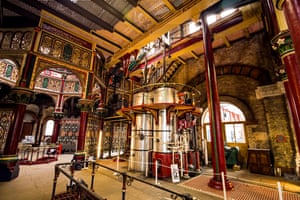When Crossness sewage works opened in Abbey Wood, south-east London, in 1866, it was the first building of its kind in the world.
The engines were shut down in the 1950s but volunteers are hoping to regularly open the Grade 1 listed Victorian pumping station for visitors.
Watch the Video BBC
Sir Joseph Bazalgette’s sewage treatment works was the first of its kind in the world and helped eradicate cholera in London

A glorious monument to the towering genius of Victorian engineering reopens this week, complete with a smart new cafe and a distinctive whiff of sewage drifting across from the working side of the Crossness sewage pumping station, south-east London.
The astonishing building, described as “a cathedral on the marsh”, was the first of its kind in the world, designed by Sir Joseph Bazalgette, chief engineer of the Metropolitan board of works, to awe and inspire visitors from across the UK and Europe. They came to marvel at his solution to the appalling problems caused by untreated sewage and contaminated water supplies in a rapidly expanding city, which led to epidemics of killer diseases including cholera.
His solution was to take sewage as far as possible from the city through gravity flow and steam-powered pumping engines, and then dump it untreated into the Thames far to the south-east of the city. When the tide was coming in, the sewage was held in a tank covering 2.6 hectares (6.5 acres), with rows of workers’ cottages and a cricket pitch on top: the workers apparently grew magnificent tomatoes.
The site reopens after a £2.7m grant from the Heritage Lottery Fund. The restoration project has added a new museum display and cafe.
The exterior is magnificent, originally including a giant humbug-striped chimney, and retains doorways modelled on Norman cathedrals and carved capitals including a portrait of Bazalgette looking down with satisfaction upon his work.
“The most common response we get is just a shocked ‘wow!’ when people see it for the first time,” said Mike Jones, one of the volunteers who helped bring the building back to life.

The four giant steam-powered beam engines – the real attraction for many of the engineering pilgrims who visit – are surrounded by a blaze of polished brass, and dazzlingly painted cast-iron columns, spiral staircases and screens ornamented with figs, included for their laxative qualities.
The engines were named after senior members of the royal family, including Queen Victoria and the Prince Consort. When they were finally decommissioned in the 1950s, the cost of dismantling them was so enormous that they were simply left idle. The Crossness Engines Trust now holds them on a peppercorn lease from Thames Water. The restoration happened thanks to thousands of hours of unpaid work by volunteers united in a passion for the heroic Victorian engineering and architecture. Their include retired railway workers and electricians, engineers, teachers, an artist, a trade union negotiator and a university historian, Peter Catterall, who came on an open day because of his interest in social and political history, and found himself conscripted.

Bazalgette’s “cathedral” was opened by the Prince of Wales in 1865. The guests included the Archbishops of Canterbury and York, and what contemporary newspaper accounts called “an excellent déjeuner” was served to 500 people.
By then at least 30,000 Londoners had died in successive cholera epidemics, but the main impetus to tackle the problem was the Great Stink of 1858, when during a steaming summer the fetid Thames was so appalling that MPs considered abandoning the Palace of Westminster, and compromised by hanging deodorising chemical-soaked sacking over the windows.
Bazalgette was wrong about the cause of cholera. Like many of his contemporaries he believed the culprit was “miasma” – basically the stench – but his solution worked, Catterall said. The last epidemic was in 1866.
The trust now hopes to increase the open days and visitor numbers. “This has been described as a retirement home for old men in boiler suits and beards,” Jones said. “We want to broaden that out a bit.”
Crossness pumping station is at Bazalgette Way, Abbey Wood, London SE2 9AQ
